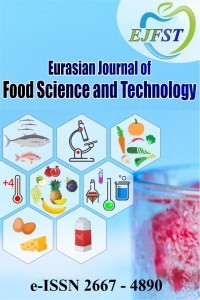Physicochemical and Nutritional Properties of Bitter Melon at Four Maturation Stages
Physicochemical and Nutritional Properties of Bitter Melon at Four Maturation Stages
antioxidant activit, nutrient, total phenol,
___
- [1]A. Aminah and P.K. Anna, “Influence of ripening stages on physicochemical characteristics and antioxidant properties of bitter gourd.” International Food Research Journal, 18, 895-900,2011.
- [2]AOAC. Official methods of analysis of AOAC international vol 2. William Horwitz. AOAC International, Washington, D.C., 1975.
- [3]AOAC. Official methods of analysis of AOAC international. William Horwitz. AOAC International, Washington, D.C., 1990.
- [4]B. Cemeroglu, Food analysis. Ankara: Bizim Buro Publication, 2007.
- [5]N. Dasgupta and B. De, “Antioxidant activity of Piper betel L. leaf extract in vitro.” Food Chem. 88, 219-224,2004.
- [6]A. Donya, N. Hettiarachchy, R. Liyanage, J. Lay, P. Chen, M. Jalaluddin. “Effects of processing methods on the proximate composition and momordicosides K and L content of bitter melon vegetable.” J. Agric. Food Chem. 11, 5827-5833,2007.
- [7]M. Freed. Methods of vitamin assay. New York: Interscience publishers.1966.
- [8]C. Gopalan, B.V. Ramasastri, S.C. Balasubramanian. Nutritive Value of Indian Foods. Hyderabad: National Institute of Nutrition, India.1993.
- [9]R. Horax, N. Hettiarachchy, S. Islam. “Total phenolic contents and phenolic acid constituents in 4 varieties of bitter melons (Momordica Charantia) and antioxidant activities of their extracts.” J. Food Sci. 70, 275-280,2005.
- [10]R. Horax, N. Hettiarachchy, A. Kannan, P. Chen. “Proximate composition and amino acid and mineral contents of Mormordica charantia L. pericarp and seeds at different maturity stages.” Food Chem. 122, 1111-1115,2010.
- [11]A.S. Kulkarni, H.B. Patil, C.G. Mundada. “Studies on effect of pretreatment on quality of dehydrated bitter gourd (Momordica charantia L.).” Adit Journal of Engineering. 2, 31-33,2005.
- [12]C. Myojin, N. Enami, A. Nagata, T. Yamaguchi, H. Takamura, T. Matoba. “Changes in the radical-scavenging activity of bitter gourd (Momordica charantia L.) during freezing and frozen storage with or without blanching.” J. Food Sci .73, 546-550,2008.
- [13]J. Kubola, S. Siriamornpun. “Phenolic contents and antioxidant activities of bitter gourd leaf, stem and fruit fraction extracts in vitro.” Food Chem. 110, 881-890,2008.
- [14]V.L. Singleton, J.A. Rossi. “Colorimetry of total phenolics with phosphomolybdic-phosphotungtic acid reagent.” Am. J. Enol. Viticult. 16, 144-158,1965.
- [15]A.K. Soomro, K.A. Ansari. “Medicinal use of bitter gourd (Momordica charantia L.) in District Sukkur, Sindh, Pakistan.” Hamdard Med. 48, 9-14,2005.
- [16]M. Stephen, J.A. Duke. The phytochemical database. Baltimore: Beckstrom-Sternberg.1994.
- [17]M. Ullah, F.K. Chy, S.K. Sarkar, M.K. Islam, N. Absar. “Nutrient and phytochemical analysis of four varieties of bitter gourd (Momordica charantia) grown in chittagong hill tracts, Bangladesh.” Asian Journal of Agricultural Research. 5, 186-193,2011.
- [18]E.K. Yuwai, K.S. Rao, C. Kaluwin, G.P. Jones, D.E. Rivett. “Chemical composition of Momordica charantia L. fruits.” J. Agric. Food Chem. 39, 1762- 1763,1991.
- Yayın Aralığı: Yılda 2 Sayı
- Başlangıç: 2017
- Yayıncı: İlknur BAĞDATLI
APPLICATION OF NANOTECHNOLOGY IN FOOD PACKAGING
Merve Gozde COSKUN, Omer Utku COPUR, Perihan Yolci OMEROGLU
An Overview of Nano-Scale Food Emulsions: A Mini Review
Şelale YALÇINÖZ, Emine ERÇELEBİ
MATHEMATICAL MODELING OF APRICOT DRYING
Temperature dependency of sweet cherry concentrate colour: a kinetic study
Şelale YALÇINÖZ, Emine ERÇELEBİ
Effects of Cultivar, Maturity Index and Growing Region on Fatty Acid Composition of Olive Oils
Songül KESEN, Asghar AMANPOUR, A. Salih SONMEZDAG, Hasim KELEBEK, Serkan SELLİ
Gülşah KANBUR, Yusuf CUFADAR, Rabia GÖÇMEN, Ahmet ÜNVER
Merve Gozde COSKUN, Perihan YOLCI OMEROGLU, Omer Utku COPUR
Physicochemical and Nutritional Properties of Bitter Melon at Four Maturation Stages
Yasin OZDEMIR, Aysun OZTURK, Senem TUFEKCI, Ozge KESKINEL, Rena İ. KOSTI
Characterization of fatty acids composition in Iranian Phishomi extra-virgin olive oil
